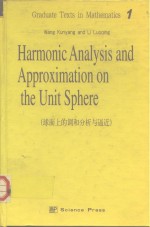

Harmonic Analysis and Approximation on the Unit Sphere 球面上的调和分析与逼近PDF电子书下载
- 电子书积分:11 积分如何计算积分?
- 作 者:Wang Kunyang,Li Luoqing著
- 出 版 社:北京:科学出版社
- 出版年份:2000
- ISBN:7030083660
- 页数:300 页
Chapter 1 Preliminaries 1
1.1 Basic concepts 1
1.1.1 Definition of ?,?and? 1
Contents 1
1.1.2 L2(Ωn)(n≥2) 4
1.1.3 The case n=2 6
1.1.4 Zonal harmonics 7
1.1.5 Representation for spherical harmonics 14
1.1.6 Laplace-Beltrami Operator 16
1.1.7 The convolution for functions on sphere 17
1.2.1 Rodrigues formula 21
1.2 Gegenbauer and Jacobi polynomials 21
1.2.2 Funk-Hecke formula 24
1.2.3 Laplace representation 26
1.2.4 Generating formulas 27
1.2.5 The leading coefficient of? 31
1.2.6 Differential equations for? 31
1.2.7 Jacobi Polynomials 32
1.3 Jacobi polynomials with complex indices 34
Chapter 2 Fourier-Laplace Series 43
2.1 Introduction 43
2.2 Convergence,Lebesgue constant 45
2.3 Cesàro means(Early results) 48
2.4 Translation operator and mean operator 56
2.5 Maximal translation operator 63
2.5.1 The proof of Theorem 2.5.1 64
2.5.2 Proof of Theorem 2.5.2 71
2.6 Projection operators 75
Chapter 3 Equiconvergent Operators of Cesàro Means 85
3.1 Definition 85
3.2 Localization 95
3.2.1 The case δ≥n-2 95
-1<δ<n-2 97
3.2.2 The necessity of antipole conditions when 97
3.2.3 Antipole conditions when?-1<δ<n-2 100
3.2.4 Corollary of Theorems 3.2.5 and 3.2.6 105
3.3 Pointwise convergence 106
3.3.1 Equivalent conditionsfor convergence 106
3.3.2 Tests for convergence 108
3.3.3 A test of Salem type 113
3.4 Maximal operatorE? and a.e.convergence 116
3.5 Application to linear summability 129
3.5.1 Introduction 129
3.5.2 Auxiliary lemmas 131
3.5.3 Convergence everywhere 142
3.5.4 Convergence at Lebesgue points 150
Chapter 4 Constructive Properties of Spherical Functions 161
4.1 Best approximation operator 161
4.2 Pointwise Derivatives 162
4.2.1 Preliminary 163
4.2.2 Estimate for the tangent gradients 165
4.2.3 Estimate for the normal gradient of harmonicpolynomials 168
4.3 Fractional derivative and integral 170
4.4.1 Definitinitions 172
4.4 Fractional integrals of variable order 172
4.4.2 Propertiesof Poisson integrals on the sphere 174
4 4.3 Proof of Theorem 4.4.1 180
4.5 Modulus of continuity 182
4.6 Derivatives and finite differences 188
Chapter 5 Jackson Type Theorems 193
5.1 Jackson inequality and K-functional 193
5.1.1 Estimates for ultraspherical polynomials 194
5.1.2 Estimates for the best approximation 212
5.1.3 Estimate for derivative of polynomials 214
5.1.4 Proofof Theorems 5.1.1 and 5.1.2 215
5.2 Difference*△?and space H? 216
Chapter 6 Approximation by Linear Means 229
6.1 Almost everywhere approximation 229
6.1.1 Introduction 229
6.1 2 Approximation by Riesz means on sets of 231
full measure 231
6.1.3 Approximation by partial sums on sets of 236
full measure 236
6.1.4 Strong approximation by Cesàro Means 241
6.2 Approximation in norm 254
6.2.1 Riesz means and Peetre K-mmoduli 254
6.2.2 Riesz means and the best approximation 257
6.2.3 Riesz means with critical index 259
6.2.4 Riesz means and Cesàro means 263
6.3 The de la Vallée Poussin Means 266
6.3.1 Convergence and approximation in norm 268
6.3.2 Pointwise convergence and approximation 270
6.3.3 Weak type inequalities for the best approximation 273
6.3.4 Characterization through a classical modulus ofsmoothness in C 275
6.3.5 Approximation for zonal functions 280
References 285
Index 299
- 《水面舰艇编队作战运筹分析》谭安胜著 2009
- 《分析化学》陈怀侠主编 2019
- 《影响葡萄和葡萄酒中酚类特征的因素分析》朱磊 2019
- 《仪器分析技术 第2版》曹国庆 2018
- 《全国普通高等中医药院校药学类专业十三五规划教材 第二轮规划教材 分析化学实验 第2版》池玉梅 2018
- 《Power BI数据清洗与可视化交互式分析》陈剑 2020
- 《行测资料分析》李永新主编 2019
- 《药物分析》贡济宇主编 2017
- 《土壤环境监测前沿分析测试方法研究》中国环境监测总站编著 2018
- 《药物分析》童珊珊,余江南 2019
- 《中风偏瘫 脑萎缩 痴呆 最新治疗原则与方法》孙作东著 2004
- 《水面舰艇编队作战运筹分析》谭安胜著 2009
- 《王蒙文集 新版 35 评点《红楼梦》 上》王蒙著 2020
- 《TED说话的力量 世界优秀演讲者的口才秘诀》(坦桑)阿卡什·P.卡里亚著 2019
- 《燕堂夜话》蒋忠和著 2019
- 《经久》静水边著 2019
- 《魔法销售台词》(美)埃尔默·惠勒著 2019
- 《微表情密码》(波)卡西亚·韦佐夫斯基,(波)帕特里克·韦佐夫斯基著 2019
- 《看书琐记与作文秘诀》鲁迅著 2019
- 《酒国》莫言著 2019
- 《指向核心素养 北京十一学校名师教学设计 英语 七年级 上 配人教版》周志英总主编 2019
- 《《走近科学》精选丛书 中国UFO悬案调查》郭之文 2019
- 《北京生态环境保护》《北京环境保护丛书》编委会编著 2018
- 《中医骨伤科学》赵文海,张俐,温建民著 2017
- 《美国小学分级阅读 二级D 地球科学&物质科学》本书编委会 2016
- 《指向核心素养 北京十一学校名师教学设计 英语 九年级 上 配人教版》周志英总主编 2019
- 《强磁场下的基础科学问题》中国科学院编 2020
- 《小牛顿科学故事馆 进化论的故事》小牛顿科学教育公司编辑团队 2018
- 《小牛顿科学故事馆 医学的故事》小牛顿科学教育公司编辑团队 2018
- 《高等院校旅游专业系列教材 旅游企业岗位培训系列教材 新编北京导游英语》杨昆,鄢莉,谭明华 2019
